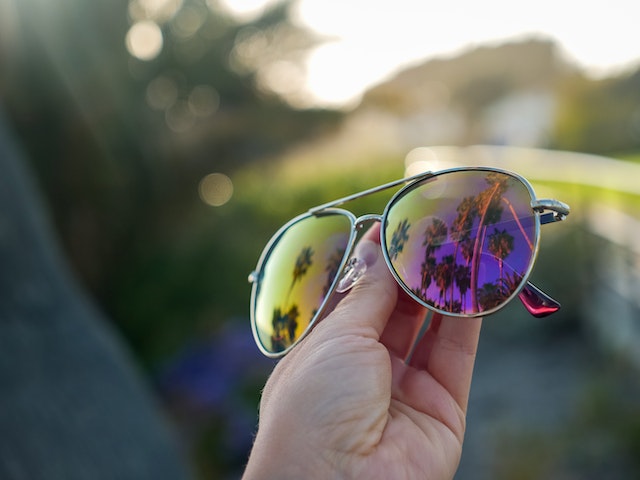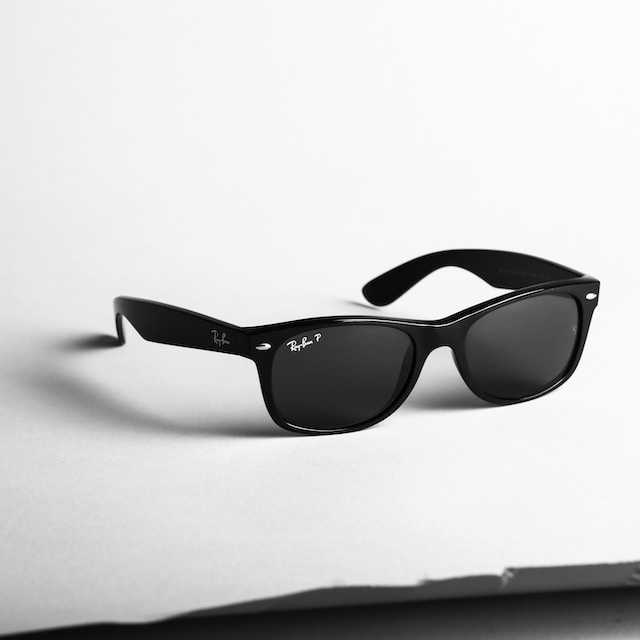Non-polarized sunglasses are great for everyday use and can provide adequate protection against UV rays. They are also generally more affordable. if you spend a lot of time near water or in bright sunlight, polarized sunglasses may be a better option as they offer superior glare reduction. They can help reduce eye strain and improve visual clarity in these conditions.
What are polarized sunglasses?
(Photo by Kindel Media)

Polarized sunglasses are a type of eyewear that is specifically designed to reduce glare and improve visibility, particularly in bright, sunny conditions. This is achieved through the use of a special filter that blocks out horizontal light waves while allowing vertical ones to pass through. Horizontal light waves are what cause the majority of glare on reflective surfaces like water or snow.
This unique filtering process makes polarized sunglasses ideal for outdoor activities such as boating, fishing, skiing, and driving. When wearing polarized lenses, you’ll be able to see clearly without being blinded by reflections off water or other shiny objects.
It’s important to note that not all polarized sunglasses are created equal. Higher quality lenses will typically offer better polarization and clarity than cheaper options. Additionally, some people may experience distortion or visual discomfort when wearing polarized glasses due to how they interact with certain types of screens or displays.
If you spend a lot of time outdoors in bright conditions and want clearer vision with less glare and eye strain, then polarized sunglasses may be worth considering.
What are non-polarized sunglasses?
(Photo by Giorgio Trovato on Unsplash )

Non-polarized sunglasses are the traditional type of sunglasses that were used before polarized lenses came into existence. These lenses do not have a special coating that blocks glare or reduces reflections. Therefore, they do not offer as much protection against bright light as polarized glasses.
Non-polarized sunglasses come in various shades and tints, such as gray, brown, green, and yellow. They can be made with materials like glass or plastic and are also available in different styles and shapes to suit everyone’s preferences.
These types of sunglasses are more affordable compared to their polarized counterparts. Non-polarized glasses can be an excellent option for people who want to protect their eyes from harmful UV rays but don’t need specialized glare-reducing features.
However, non-polarized lenses may not be suitable for some activities like water sports where there is a lot of reflected light that can cause eye strain or discomfort. Additionally, these lenses may not provide adequate visibility while driving on wet roads or during harsh weather conditions.
Non-polarized sunglasses are a good choice for individuals looking for affordable eye protection without specific glare reduction qualities. However, they may not be ideal for certain outdoor activities where excessive sunlight and reflection pose significant risks to vision health.
Polarized sunglasses Vs. Non-polarized sunglasses – Key differences
Polarized sunglasses and non-polarized sunglasses may look similar at a glance, but they have some significant differences. The key difference between the two is how they filter light.
Non-polarized sunglasses help reduce the amount of visible light that enters your eyes, making things appear darker and more comfortable to see in bright sunlight. However, non-polarized lenses don’t effectively block reflected light or glare from surfaces like water or snow.
In contrast, polarized lenses contain a special filter that blocks intense reflected light and reduces glare. This makes them ideal for activities like fishing, boating or driving because they can improve visibility and reduce eye strain even on sunny days.
Another important thing to note is that not all polarized lenses are created equal – cheaply made polarized lenses can cause distortion or color imbalance. It’s essential to find high-quality polarizing filters for optimal results.
If you spend time near reflective surfaces or participate in outdoor activities, investing in a pair of high-quality polarized sunglasses might be worth it. However, if you only need basic sun protection without worrying about glare reduction then inexpensive non-polarized glasses may suffice.
The benefits of non-polarized sunglasses
Non-polarized sunglasses have been around for decades, and they continue to be a popular choice among many people. These types of sunglasses are designed with lenses that do not contain any polarizing filters. As a result, they offer unique benefits that polarized sunglasses cannot provide.
One of the key advantages of non-polarized sunglasses is their ability to enhance color perception. Unlike polarized lenses that can sometimes distort colors or make them appear dull, non-polarized lenses allow you to see true and vibrant colors in the world around you.
Another benefit is that these sunglasses tend to be more affordable than their polarized counterparts. This makes them an excellent option if you’re on a budget but still want high-quality eye protection.
In addition, non-polarized sunglasses can be used by anyone, including individuals who are sensitive to certain types of light. Since they don’t filter out specific wavelengths of light like polarized lenses do, they offer greater versatility in various lighting conditions.
Non-polarized sunglasses also reduce glare from reflective surfaces such as water or snow without affecting your depth perception – making them ideal for activities such as driving or playing sports outdoors.
While both types of sunglasses have their own unique benefits and drawbacks; it’s important to choose one based on your individual needs and preferences.
The benefits of polarized sunglasses
Polarized sunglasses are a popular choice for those who spend time outside, whether for work or leisure. These types of sunglasses offer a number of benefits to the wearer that make them worth considering.
One of the main advantages of polarized sunglasses is their ability to reduce glare. This can be especially helpful when driving, as it can improve visibility and reduce eye strain. Additionally, polarized lenses can help enhance color contrast and clarity, making it easier to see objects in bright sunlight.
Another benefit of polarized sunglasses is their ability to protect against harmful UV rays from the sun. Exposure to these rays over time can lead to cataracts and other eye problems. By wearing polarized sunglasses with UV protection, you are helping to keep your eyes healthy in the long term.
Wearing polarized sunglasses can also be beneficial for athletes and outdoor enthusiasts who need clear vision while performing activities such as fishing or skiing. The reduced glare provided by these lenses allows them to better see what they’re doing without being distracted by reflections on water or snow.
If you spend a lot of time outdoors or simply want better eye protection while driving, upgrading to a pair of high-quality polarized sunglasses could be a wise investment.
How to choose the right type of sunglasses for you?
Choosing the right type of sunglasses can be overwhelming, but it doesn’t have to be. Start by considering your lifestyle and needs. If you spend a lot of time outdoors near water or snow, polarized sunglasses may be a good choice for reducing glare. On the other hand, if you’re frequently indoors or driving in low light conditions, non-polarized lenses may suffice.
Next, consider the shape and size of your face. Round faces typically look best with square or rectangular frames while angular faces are complemented by rounder shapes. Additionally, larger frames tend to suit people with bigger faces while smaller frames flatter those with narrower faces.
Don’t forget about UV protection – all sunglasses should offer 100% protection from harmful UVA and UVB rays. Look for labels that indicate this level of protection before purchasing any pair.
Don’t shy away from trying on multiple pairs until you find one that suits both your style and practical needs. With these tips in mind, finding the perfect pair of sunglasses is just within reach!
Featured Image By – Photo by Nitin Dhumal








